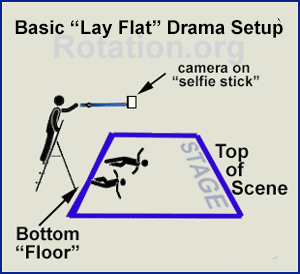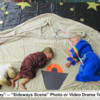"Flat Lay," "Lay Flat," "Bird's Eye" or "Sideways Scene"
Photo and Video Drama Technique
This post describes a dramatic adaptation of a fun photographic technique originally called "flat lay" in photography circles but which we now call "lay flat" for ease of explanation. it's also known as "bird's eye" or "sideways scene." By any name, it's a fun way to dramatize Bible scenes and their message.
"Flat Lay" or Lay Flat describes the purposeful arrangement of objects, words, materials (etc) on a flat surface and then taking a photo (or video recording) of the arrangement (or action) from ABOVE (bird's eye view), This technique is commonly found on Instagram and YouTube to display products and parts of products on a table. It is considered an art medium. Google "flat lay" for lots of examples.
"Flat Lay" is also known as "Sideways Scene" in improv circles -- where the actors present a scene/story while lying on the floor with the camera above them. Actors have to "scoot" as they try to walk while lying on the floor, and because they are lying on the floor, the "gravity" or physics of what the observer sees is usually hilarious (or "memorable" as we like to say).
Here's a great example of one church's "sideways scene" Christmas skit.
Okay, they had a "door," but our classroom "flat lay sideways scenes" are much simpler, ...a square taped on the floor with a teacher holding a cellphone video camera on a selfie stick above the scene (having a ladder and stick really helps frame the scene).
It really is that simple. You just need the kids to rehearse and really think about how you can play out your Bible story/scene in "flat lay" that will be fun as well as memorable.
If you're one of our supporting members, take a look at the Writing Team's Psalm 23 Flat Lay Drama Workshop. it has a "SCENE GUIDES" which breaks down the psalm into 7 scenes with suggested movements. The kids discuss and complete the guide before rehearsing it then performing it for the outstretched camera. The "Scene Guide" approach is great template for approaching just about any Flat Lay drama you might consider, such as a Prodigal Son Flat Lay Drama, or Lord's Prayer.
Here's a "flat lay" photo from the Writing Team's "Shepherds and Angels" Drama lesson.

Here's how it looked at one church prepping their Luke 2 Angels and Shepherds story "Flat Lay" sideways scene video.
It's still what we might otherwise call "posing Bible scenes," or creating "tableaux," or "action freeze frames." But it's not going to look like this old-fashioned posed photo:

By laying our actors flat on the floor and photographing them from above, we not only gain an extra dimension, we can now "suspend gravity" to accentuate posed positions which are not possible if you're standing upright. It's particularly funny when you do a video recording of the actors acting in the scene, but it looks cool even when you're just creating still scenes. There's something about playing a trick on the eye that makes us pay attention and enjoy viewing and discussing our scenes.
CreativeCarol, a member of our Writing Team, has written a Writing Team DRAMA lesson that uses "flat lay" photography to create "tableaux" (creative photos) of various scenes and the reactions/messages found in Luke 2's Shepherds and Angels story.
Using a Video Camera to Record a "Lay Flat" Action Scene
In the above description of a "flat lay tableaux." actors still "freeze" to be photographed while they lay on the floor. But in "Flat Lay Action," we let the actors act out the focus of a story scene and the reactions to what's happening or being said while they lay flat on the floor and we record the scene from above.
And here's the cool effect that creates... When played back on the TV, the "physics" of watching the kids scoot around on the floor are humorous, allowing for bigger actions and reactions because you don't have gravity anchoring your feet to the ground.
Neil MacQueen, another member of our Writing Team, has written a Writing Team "Bethelehem Live Music Television Show" lesson that uses a cellphone/camera's video recording capabilities to create the effect of a "live tv show" while recording the show at the same time.
That lesson uses the "flat lay" technique with live actors moving on the floor. This type of comedy skit is known as "sideways scene." It has been popularized by improv shows and the "Whose Line Is It Anyway" TV show whose sideways scene skits can be found on YouTube. You can do sideways scenes of the scenes and dialog of the Bible story (photographed or video recorded.
How to connect your cellphone/video camera to your TV to show a LIVE FEED of the sideways scene. You don't need to have a live feed of your video going to your TV (as described in Neil's lesson), but you will want to have the ability to connect your camera to your TV so you can playback the recording and enjoy the acting and fun effect of "flat lay" action dramas.
















